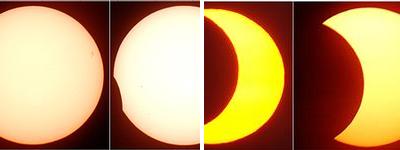Tens of thousands of believers gathered in rivers in northern India to participate in the "holy washing"; In Norway, about 20 thousand people gathered in the streets of Oslo and applauded; In Israel, an eclipse of about 54% is visible at sunrise * report from the observatory in Givatayim
Shai Chalazi, Israel Astronomical Society

The phases of the eclipse as photographed in Austria
Over the weekend, heavy cloudiness and local rain made it difficult to view the solar eclipse, which was visible in large parts of the Earth on the night between Friday and Saturday, May 31, 2003. In Israel, an eclipse of about 54% was visible at sunrise, at 05:39 in the morning, and for about an hour. Around the world, the event was celebrated with a series of ceremonies and celebrations: in Norway, about 20 gathered in the streets of Oslo and applauded the performance of the "Ring of Fire"; In India, tens of thousands of believers gathered in the rivers in the north of the country, to participate in the "holy washing".
A solar eclipse is an astronomical phenomenon that occurs when the Moon passes between the Earth and the Sun. The moon (like the earth) cannot illuminate itself, and it is possible to witness it through light coming from the sun. During a solar eclipse, the moon hides part of the sun. This phenomenon occurs even though the Sun is much larger than the Moon, because it is also further away from the Earth. Therefore, for an observer standing exactly on the continuation of the imaginary line connecting the sun and the moon, the moon will appear to hide almost the entire sun. When the center of the moon is not exactly on the line connecting the observer with the sun, a partial solar eclipse will be seen.
Astronomy enthusiasts this time focused on Scotland and Ireland, where it was possible to witness the moon covering almost the entire disk of the sun. However, heavy cloudiness, large amounts of dust and local rain prevented witnessing the phenomenon.
The Indians believe that bathing in the state's rivers during a solar eclipse will allow the soul to free itself from the cycle of life after death. As a result, tens of thousands of Indians flocked to the north of the country, and the authorities had difficulty controlling the crowds that flooded the rivers. The religious ceremony, known as the "holy ablution", took on a special meaning this time because it was the first solar eclipse in India in the current millennium.
Every year two to five solar eclipses can be seen from Earth. However, in Israel it is possible to witness an eclipse only once every few years, since the eclipse is a local phenomenon, often visible from a limited area of the earth. The next solar eclipse is expected to occur on November 23, but it will only be visible from the surface of Antarctica. According to the astronomers' data, the next partial solar eclipse that will be visible from Israel is expected only on October 3, 2005.

The peak of the eclipse was visible in the North Atlantic Ocean - and this time it was an annular rather than a total eclipse
*******
Shai Halatzi from the Israeli Astronomical Society reported during Shabbat at the Tapuz Astronomy Forum: The people who came to the observatory (there were about 200) received explanations in the lecture room and then proceeded to the observation. They saw the sunrise projected on the wall in the balcony, and after it rose a little in height, they went down to observe with ETX90 and eclipse glasses from the garden (the structure of the observatory did not allow observation from the balcony).
The clouds mainly disturbed us at sunrise (we did not see the sun rise from the horizon, but from clouds at a height of about 3 degrees) and then covered it from time to time for short periods of time. I saw the end of the eclipse (last contact) with great difficulty through the ETX just as the sun came out of the cloud, but I still managed.
The people watching through the telescope and glasses had a lot of fun and marveled at the poor sun and its spots.
In short - a very successful activity!
Many thanks to everyone who bothered to come, explain, watch and take pictures. Nadav Rotenberg, Yigal Fat-El, Albert Kalifa, Andreas Hidenreich, Yigal Eliyahu, Yuval Yelin, Ofer Gabzou, Moran Nachshoni, Elis Nachmias, Yehuda Sabdarmish and Yair Farber. Special thanks to Nadav Rotenberg who worked for days on preparing the equipment for the broadcast, and to Legal Fat-El who kindly lent the telescope and filters for the broadcast. Good luck to everyone!
For news at the BBC
